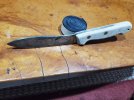When we went to mo moms for Christmas she gave me two of my grand mothers old knives to clean up and sharpen. These are old carbon steel blades with wood handles. They are both partial tang with grooves cut in the wood and brass rivets holding them together. They were sharpened on an electric sharpener on the back of an electric can opener for many years. They’re both at least 50 years old and likely 65 - 70 years old.
I’d like to remove the old handles, clean the tangs, & correct some profile deformities like severe recurves and such. Then I want to replace the handles and sharpen them. Is there a standard way to make these slotted style handles? How much tolerance is there in the size of the slot? If I want a perfect fit, I’ll likely have to laminate some woods together. They certainly aren’t a perfect fit now, so maybe that’s not necessary.
I’d like to remove the old handles, clean the tangs, & correct some profile deformities like severe recurves and such. Then I want to replace the handles and sharpen them. Is there a standard way to make these slotted style handles? How much tolerance is there in the size of the slot? If I want a perfect fit, I’ll likely have to laminate some woods together. They certainly aren’t a perfect fit now, so maybe that’s not necessary.






